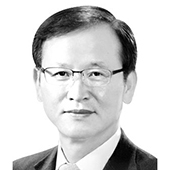Create innovative habitat like in New York

Yoon Seok-jin
The author is president of the Korea Institute of Science and Technology.
I have been to the New Lab, an innovation cluster in Brooklyn, New York. The lab housed in a renovated building of the Brooklyn Navy Yard in New York City was the place where a number of U.S. warships that appear in the history of great naval battles were built. USS Missouri — transformed into a museum resting in the heart of Pearl Harbor now but the indomitable battleship on which the Japanese Surrender took place on September 2, 1945 — also was built there. The magnificent battleship, also active during the Korean War, was the first U.S. warship that arrived to the Korean Peninsula and took part in the Hungnam evacuation in which the U.S. Navy and merchant ships rushed to evacuate tens of thousands of North Koreans to the south.
The Navy Yard symbolizes the U.S.’s ascension to a superpower and the protector of the Free World. But it’s also the vibrant venue where an army of scientists and engineers are being born to buttress the technology hegemony of the U.S. in the 21st century. In a visit to the New Lab, I was shocked at the vitality, ingenuity and dynamism filling the place.
I felt a special sense of pride there. A start-up launched by graduates from the Korea Institute of Science and Technology (KIST) was under the spotlight for their endeavor to develop a promising hydrogen-based technology. Members of the group were all devoted to devising a cutting-edge technology to extract hydrogen from ammonia for secondary batteries and applying it to drones, tractors, cargo trucks and vessels.
Hydrogen is not only pivotal to the economy but also constitutes a core technology for Korea’s national security strategy. The problem was low economic feasibility. As a result, hydrogen technology has been perceived as the one for a bit distant future. But the New Lab showed that as long as scientists can demonstrate creativity powerful enough to draw a future market to their labs, investors and industrialists pay attention to them.
In Boston, about 300 kilometers (186 miles) from the New Lab in New York, there is another cutting-edge bio and medical cluster. They are also considered as the fields where scientists can hardly go beyond their lab. But inspirational entrepreneurs have succeeded in meeting the needs of companies to find a new growth engine for the future. Thanks to their unceasing efforts, Boston could be born again as the world’s largest bio and medical hub now outpacing San Francisco and San Diego.
The Yoon Suk Yeol administration concentrates on fostering hydrogen, bio, semiconductor and quantum technologies as 12 strategic technologies of the country to weather the turbulent process of rebuilding the global supply chains amid the heated technology contest between the U.S. and China. The government aims to cultivate new industries to help secure stable supplies and raise Korea’s declining growth, as well as promote the country’s diplomatic and security interests. To achieve the goal, the government has set the foundation for strong support for the strategic technologies by enacting a special law and rearranging the entities for the transformation.
The New Lab and the bio cluster in Boston could succeed primarily thanks to the market mechanism connecting the future market to the realm of research and development. Through that process, the two cities could create an innovative ecosystem that gives powerful motivation to scientists. Different from the past, today’s top-caliber talent is not swayed by their pay or position, but is driven by inspiration.
The Yoon administration should establish a symbiotic habitat, where all talents from the world can come and compete, by linking a future market to R&D in the lab. That is global standards. And it all starts with brains. The president’s uninterrupted meetings with scientists and engineers wherever he goes reflect his judgment that Korea’s future depends on science and technology and that scientists hold the very key to opening a bright future.
The government has scrapped the uniform “blind recruitment” at public research institutes to allow them to hire more qualified talent instead of blindly sticking with the egalitarian practice. The government is also on a crusade to remove multilayered regulations blocking enterprises from conducting world-class research. It must provide fertile ground for scientists to demonstrate their creativity and bring a soon-to-come market to their labs. That is the zeitgeist of the times — and the mission for government-funded research institutes across the country.
Translation by the Korea JoongAng Daily staff.










with the Korea JoongAng Daily
To write comments, please log in to one of the accounts.
Standards Board Policy (0/250자)